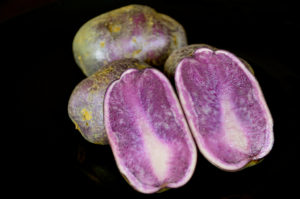
Did you know purple potatoes were a thing? If you are like most people you are only familiar with the typical white or sweet potatoe.
So what is the difference. Well, mainly, purple potatoes contain Anthocyanin which is a pigment that creates the purple color in the potatoes and also acts as an antioxidant.
If you want the 411 on the different fact and nutritional benefits of purple potatoes, this new post from our friends at Collective Evolution goes into all the details:
“Purple Potatoes Pack Mega Antioxidants Compared To White-Fleshed Potatoes
Most of us are used to seeing and eating the typical white or yellow fleshed potatoes. You may even eat sweet potatoes on a regular basis and so you might be accustomed to orange as well. But purple potatoes are certainly not as popular, although given the deep rich color of these potatoes, more of us should be familiar with these potatoes for the powerful nutrients they pack.
Native to South America, purple potatoes got their name due to their deep purple skin and flesh. There are several types of the purple potato including the Purple Majesty, Purple Viking and Purple Peruvian varieties. Purple potatoes are rich in antioxidant phytochemicals and studies show that purple potatoes can aid in lowering blood pressure.
As with any fruit or vegetable, the deep rich colors they offer tell us how nutrient dense they are. When choosing which vegetables to add to our diet, a mix of colors is always a good rule of thumb to be sure we are getting a variety of nutrients to meet our bodies needs. Purple potatoes follow right along with this concept as the purple characteristic tell us that they are rich in a powerful antioxidant called anthocyanin. Coming from the flavonoid family of antioxidants, anthocyanin is best known for boosting the immune system and fighting cancer. You can also find this antioxidant in blueberries and pomegranates.
Another great benefit to anthocyanin is its ability to protect the integrity and structure of DNA and encourage the production of cytokines which are key in promoting proper immune response. If that isn’t enough, this powerful antioxidant also has anti-inflammatory properties, helps to protect the health and integrity of the capillaries and strengthens membranes. It may also play a role in regulating estrogenic activity which helps to lower the risk of hormone-related disease.”
While they are purple, don’t be fooled: they don’t taste like eggplant or even a purple grape. And how do you cook Purple potatoes? These answers and more are revealed in the rest of the post from Collective-Evolution including how the may lower blood pressure. Click the link below to finish the article:
Photo By DennisGRILLT